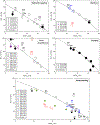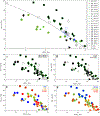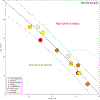A Systematic Post-QUANTEC Review of Tolerance Doses for Late Toxicity After Prostate Cancer Radiation Therapy
- PMID: 30125635
- PMCID: PMC6652194
- DOI: 10.1016/j.ijrobp.2018.08.015
A Systematic Post-QUANTEC Review of Tolerance Doses for Late Toxicity After Prostate Cancer Radiation Therapy
Abstract
Purpose: The aims of this study were to systematically review tolerance doses for late distinct gastrointestinal (GI), genitourinary (GU), and sexual dysfunction (SD) symptoms after external beam radiation therapy (EBRT) alone and treatments involving brachytherapy (BT) for prostate cancer after Quantitative Analysis of Normal Tissue Effects in the Clinic (QUANTEC) and ultimately to perform quantitative syntheses of identified dose/volume tolerances represented by dose-volume histogram (DVH) thresholds, that is, statistically significant (P ≤ .05) cutoff points between symptomatic and asymptomatic patients in a certain study.
Methods and materials: PubMed was scrutinized for full-text articles in English after QUANTEC (January 1, 2010). The inclusion criteria were randomized controlled trials, case-control studies, or cohort studies with tolerance doses for late distinct symptoms ≥3 months after primary radiation therapy for prostate cancer (N > 30). All DVH thresholds were converted into equivalent doses in 2-Gy fractions (EQD2α/β) and were fitted with a linear or linear-quadratic function (goodness of fit, R2). The review was registered on PROSPERO (CRD42016042464).
Results: From 33 identified studies, which included 36 to 746 patients per symptom domain, the majority of dose/volume tolerances were derived for GI toxicity after EBRT alone (GI, 97 thresholds; GU, 8 thresholds; SD, 1 threshold). For 5 symptoms (defecation urgency, diarrhea, fecal incontinence, proctitis, and rectal bleeding), relationships between dose/volume tolerances across studies (R2 = 0.93 [0.82-1.00]), and across symptoms, leading to a curve for overall GI toxicity (R2 = 0.98), could be determined. For these symptoms, mainly rectal thresholds were found throughout low and high doses (10 Gy ≤ equivalent dose in 2-Gy fractions using α/β = 3Gy (EQD23) ≤ 50 Gy and 55 Gy ≤ EQD23 ≤ 78 Gy, respectively). For BT with or without EBRT, dose/volume tolerances were also mainly identified for GI toxicity (GI, 14 thresholds; GU, 4 thresholds; SD, 2 thresholds) with the largest number of DVH thresholds concerning rectal bleeding (5 thresholds).
Conclusions: Updated dose/volume tolerances after QUANTEC were found for 17 GI, GU, or SD symptoms. A DVH curve described the relationship between dose/volume tolerances across 5 GI symptoms after EBRT alone. Restricting treatments for EBRT alone using the lower boundaries of this curve is likely to limit overall GI toxicity, but this should be explored prospectively. Dose/volume tolerances for GU and SD toxicity after EBRT alone and after BT with or without EBRT were scarce and support further research including data-sharing initiatives to untangle the dose/volume relationships for these symptoms.
Copyright © 2018 Elsevier Inc. All rights reserved.
Figures




Similar articles
-
Acute genitourinary toxicity after high-dose-rate (HDR) brachytherapy combined with hypofractionated external-beam radiation therapy for localized prostate cancer: correlation between the urethral dose in HDR brachytherapy and the severity of acute genitourinary toxicity.Int J Radiat Oncol Biol Phys. 2005 Oct 1;63(2):463-71. doi: 10.1016/j.ijrobp.2004.11.041. Int J Radiat Oncol Biol Phys. 2005. PMID: 16168838
-
Comparison of acute and late toxicities for three modern high-dose radiation treatment techniques for localized prostate cancer.Int J Radiat Oncol Biol Phys. 2012 Jan 1;82(1):204-12. doi: 10.1016/j.ijrobp.2010.10.009. Epub 2010 Dec 16. Int J Radiat Oncol Biol Phys. 2012. PMID: 21167653 Clinical Trial.
-
Late toxicity after intensity-modulated radiation therapy for localized prostate cancer: an exploration of dose-volume histogram parameters to limit genitourinary and gastrointestinal toxicity.Int J Radiat Oncol Biol Phys. 2012 Jan 1;82(1):235-41. doi: 10.1016/j.ijrobp.2010.09.058. Epub 2010 Dec 14. Int J Radiat Oncol Biol Phys. 2012. PMID: 21163587
-
Pelvic Complications After Prostate Cancer Radiation Therapy and Their Management: An International Collaborative Narrative Review.Eur Urol. 2019 Mar;75(3):464-476. doi: 10.1016/j.eururo.2018.12.003. Epub 2018 Dec 17. Eur Urol. 2019. PMID: 30573316
-
Dose-escalated radiotherapy for clinically localized and locally advanced prostate cancer.Cochrane Database Syst Rev. 2023 Mar 8;3(3):CD012817. doi: 10.1002/14651858.CD012817.pub2. Cochrane Database Syst Rev. 2023. PMID: 36884035 Free PMC article. Review.
Cited by
-
Radiotherapy-induced toxicity in prostate cancer patients with hip prostheses.Radiat Oncol. 2022 Jan 17;17(1):9. doi: 10.1186/s13014-021-01975-3. Radiat Oncol. 2022. PMID: 35039065 Free PMC article.
-
Increased Dose to Organs in Urinary Tract Associates With Measures of Genitourinary Toxicity in Pooled Voxel-Based Analysis of 3 Randomized Phase III Trials.Front Oncol. 2020 Jul 22;10:1174. doi: 10.3389/fonc.2020.01174. eCollection 2020. Front Oncol. 2020. PMID: 32793485 Free PMC article.
-
External Validation of a Predictive Model of Urethral Strictures for Prostate Patients Treated With HDR Brachytherapy Boost.Front Oncol. 2020 Jun 11;10:910. doi: 10.3389/fonc.2020.00910. eCollection 2020. Front Oncol. 2020. PMID: 32596153 Free PMC article.
-
Estimation of the risk of secondary cancer in rectum and bladder after radiation therapy for prostate cancer using a feasibility dose-volume histogram.Phys Imaging Radiat Oncol. 2023 Jul 5;27:100468. doi: 10.1016/j.phro.2023.100468. eCollection 2023 Jul. Phys Imaging Radiat Oncol. 2023. PMID: 37520638 Free PMC article.
-
Refinement & validation of rectal wall dose volume objectives for prostate hypofractionation in 20 fractions.Clin Transl Radiat Oncol. 2020 Jan 31;21:91-97. doi: 10.1016/j.ctro.2020.01.006. eCollection 2020 Mar. Clin Transl Radiat Oncol. 2020. PMID: 32072030 Free PMC article.
References
-
- Emami B, Lyman J, Brown A, Coia L, Goitein M, Munzenrider JE, Shank B, Solin LJ, Wesson M. Tolerance of normal tissue to therapeutic irradiation. Int J Radiat Oncol Biol Phys 1991; 21:109–22 - PubMed
Publication types
MeSH terms
Grants and funding
LinkOut - more resources
Full Text Sources
Other Literature Sources
Medical

